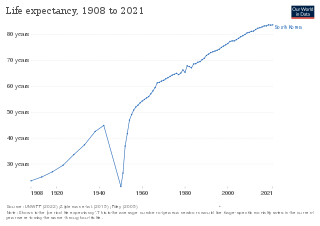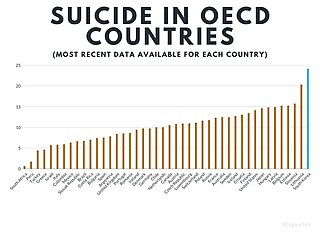Related Research Articles
Suicide is the second leading cause of death for people in the United States from the ages of 9 to 56.

Suicide prevention is a collection of efforts to reduce the risk of suicide. Suicide is often preventable, and the efforts to prevent it may occur at the individual, relationship, community, and society level. Suicide is a serious public health problem that can have long-lasting effects on individuals, families, and communities. Preventing suicide requires strategies at all levels of society. This includes prevention and protective strategies for individuals, families, and communities. Suicide can be prevented by learning the warning signs, promoting prevention and resilience, and committing to social change.
There are more than 700,000 estimated suicide deaths every year. Suicide affects every demographic, yet there are some populations that are more impacted than others. For example, among 15–29 year olds, suicide is much more prominent; this being the fourth leading cause of death within this age group.

Gun-related violence is violence committed with the use of a firearm. Gun-related violence may or may not be considered criminal. Criminal violence includes homicide, assault with a deadly weapon, and suicide, or attempted suicide, depending on jurisdiction. Non-criminal violence includes accidental or unintentional injury and death. Also generally included in gun violence statistics are military or para-military activities.
In Japan, suicide is considered a major social issue. In 2017, the country had the seventh highest suicide rate in the OECD, at 14.9 per 100,000 persons, and in 2019 the country had the second highest suicide rate among the G7 developed nations.

Health in Switzerland relates to a variety of issues. Namely, water and sanitation, diet and fitness, various addictions, mental fitness, communicable diseases, hygiene and the environment.

Life expectancy has been rising rapidly and South Korea ranked 3rd in the world for life expectancy. South Korea has among the lowest HIV/AIDS adult prevalence rate in the world, with just 0.1% of the population being infected, significantly lower than the U.S. at 0.6%, France's 0.4%, and the UK's 0.3% prevalence rate. South Korea has a good influenza vaccination rate, with a total of 43.5% of the population being vaccinated in 2019. A new measure of expected human capital calculated for 195 countries from 1920 to 2016 and defined for each birth cohort as the expected years lived from age 20 to 64 years and adjusted for educational attainment, learning or education quality, and functional health status was published by the Lancet in September 2018. South Korea had the sixth highest level of expected human capital with 26 health, education, and learning-adjusted expected years lived between age 20 and 64 years.

The major causes of deaths in Finland are cardiovascular diseases, malignant tumors, dementia and Alzheimer's disease, respiratory diseases, alcohol related diseases and accidental poisoning by alcohol. In 2010, the leading causes of death among men aged 15 to 64 were alcohol related deaths, ischaemic heart disease, accident, suicides, lung cancer and cerebrovascular diseases. Among women the leading causes were breast cancer, alcohol related deaths, accidents, suicides, ischaemic heart disease and lung cancer.

Suicide in South Korea occurs at the 12th highest rate in the world. South Korea has the highest recorded suicide rate in the OECD. In South Korea, it is estimated to affect 0.02 percent of the population by the WHO. In 2012, suicide was the fourth-highest cause of death. The suicide rate has consistently declined between 2012 and 2019, the year when the latest data are available.
Research has found that attempted suicide rates and suicidal ideation among lesbian, gay, bisexual, and transgender (LGBT) youth are significantly higher than among the general population.
World Suicide Prevention Day (WSPD) is an awareness day always observed on 10 September every year, in order to provide worldwide commitment and action to prevent suicides, with various activities around the world since 2003. The International Association for Suicide Prevention (IASP) collaborates with the World Health Organization (WHO) and the World Federation for Mental Health (WFMH) to host World Suicide Prevention Day. In 2011 an estimated 40 countries held awareness events to mark the occasion. According to WHO's Mental Health Atlas released in 2014, no low-income country reported having a national suicide prevention strategy, while less than 10% of lower-middle income countries, and almost a third of upper-middle and high-income countries had.
Suicide is a major national public health issue in the India. 1.71 lakh suicides were recorded in 2022, registering a 4.2% increase over 2021 and a jump of 27% compared to 2018. The rate of suicide per one lakh population has increased to 12.4 in 2022 which is the highest rate of deaths from suicides since 1967, which is the earliest recorded year for this data. Suicides during 2022 increased by 27% in comparison to 2018 with India reporting highest number of suicides in the world. India's contribution to global suicide deaths increased from 25.3% in 1990 to 36.6% in 2016 among women, and from 18.7% to 24.3% among men. In 2016, suicide was the most common cause of death in both the age groups of 15–29 years and 15–39 years. Daily wage earners accounted for 26% of suicide victims, the largest group in the suicide data.

According to the latest available data, Statistics Canada estimates 4,157 suicides took place in Canada in 2017, making it the 9th leading cause of death, between Alzheimer's disease (8th) and cirrhosis and other liver diseases (10th). In 2009, there were an estimated 3,890 suicide deaths.

A new measure of expected human capital calculated for 195 countries from 1990 to 2016 and defined for each birth cohort as the expected years lived from age 20 to 64 years and adjusted for educational attainment, learning or education quality, and functional health status was published by The Lancet in September 2018. Latvia had the twenty-first highest level of expected human capital with 23 health, education, and learning-adjusted expected years lived between age 20 and 64 years.

As of 2019 Lithuanian life expectancy at birth was 76.0 and the infant mortality rate was 2.99 per 1,000 births. This is below the EU and OECD average.

Suicide is a significant national social issue in the United Kingdom. In 2019 there were 5,691 registered deaths by suicide in England and Wales, equating to an average of 18 suicides per day. Suicide is the single biggest killer of men under the age of 45 in the country.

Sweden has a suicide rate which was below the OECD average. During the 1960s, Sweden had one of the highest reported suicide rates among the most developed countries, but it declined as methods for measuring were standardized internationally.
In 2014, the WHO ranked Nepal as the 7th in the global suicide rate. The estimated annual suicides in Nepal are 6,840 or 24.9 suicides per 100,000 people. Data on suicide in Nepal are primarily based on police reports and therefore rely on mortality statistics. However, the burden of suicide in communities is likely to be higher, particularly among women, migrant workers, and populations affected by disasters.
Suicide in Ireland has the 17th highest rate in Europe and the 4th highest for the males aged 15–25 years old which was a main contributing factor to the improvement of suicides in Ireland.
References
- 1 2 Nerijus Adomaitis (9 April 2008). "Suicides in Lithuania show social pains persist". Reuters. Retrieved 19 May 2021.
- ↑ "Suicides in Lithuania decrease, still above EU average". Lithuanian Radio and Television. 17 February 2020. Retrieved 19 May 2023.
- 1 2 "OECD Data: Suicide rates". OECD.
- 1 2 https://www.hi.lt/uploads/Institutas/leidiniai/Statistikos/Mirties_priezastys/Mirties_priezastys_2022(3)%20(1).pdf
- 1 2 "Suicide in Eastern Europe, the CIS, and the Baltic Countries: Social and Public Health Determinants" (PDF). The International Institute for Applied Systems Analysis. February 2013. Retrieved 19 May 2021.
- ↑ Rahman Haghighat (November 1997). "Psychiatry in Lithuania: the highest rate of suicide in the world" (PDF). Psychiatric Bulletin. 21 (11): 716–719. doi: 10.1192/pb.21.11.716 .
- ↑ "Pradeda veikti Savižudybių prevencijos biuras". Lithuanian Radio and Television. 5 January 2015. Retrieved 19 May 2021.
- ↑ Ramune Kalediene; Skirmante Starkuviene; Jadvyga Petrauskiene (2006). "Social dimensions of mortality from external causes in Lithuania: do education and place of residence matter?". Sozial- und Präventivmedizin. 51 (4): 232–239. doi:10.1007/s00038-006-4069-y. PMID 17193785. S2CID 23510788.
- ↑ "Savižudybių statistika". State Mental Health Centre.
- 1 2 Mariarosaria Comunale (July 2020). "The persistently high rate of suicide in Lithuania: an updated view" (PDF). Bank of Lithuania . Retrieved 19 May 2021.
- ↑ Victoria Baranov; Ralph De Haas; Pauline A. Grosjean (12 October 2018). "Men. Roots and Consequences of Masculinity Norms". UNSW Business School Research Paper. SSRN 3185694.
- ↑ "Sveikatos priežiūros paslaugų su savižudybės rizika susijusiems asmenims prieinamumo vertinimas" (PDF) (in Lithuanian). Suicide Prevention Bureau under the State Mental Health Centre. 2017.
- ↑ "Savo veiklą pradėjo Savižudybių prevencijos biuras". Ministry of Health (Lithuania). 2 January 2015. Retrieved 19 May 2021.
- ↑ "Suicide prevention and aid to individuals related to the risk of suicide". National Audit Office of Lithuania. 23 February 2017.
- ↑ "Suicide rates (per 100,000), by gender, Lithuania, 1981-2009" (PDF). World Health Organization. Retrieved 3 December 2012.
- ↑ "GHO | By category | Suicide rate estimates, age-standardized - Estimates by country". WHO. Retrieved 19 May 2021.